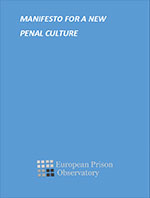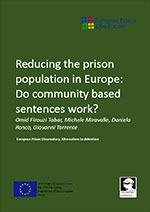- Albania
- Andorra
- Austria
- Belgium
- Bosnia and Herzegovina
- Bulgaria
- Croatia
- Cyprus
- Czech Republic
- Denmark
- Estonia
- France
- Finland
- Georgia
- Germany
- Greece
- Hungary
- Iceland
- Ireland
- San Marino
- Italy
- Kosovo
- Latvia
- Liechtenstein
- Lithuania
- Luxembourg
- Macedonia (F.Y.R.O.M.)
- Malta
- Moldova
- Monaco
- Montenegro
- Netherlands
- Norway
- Poland
- Portugal
- Romania
- Serbia
- Slovakia
- Slovenia
- Spain
- Sweden
- Switzerland
- United Kingdom
Alternatives - Out of the shadow
Here you can find a short video, based on interviews to experts on prison serving and alternatives to detention, produced with the contribution of all project partners. The main goal of this product is to convey the different impact on the offender of serving a sentence in or outside prison, and the likely different outcomes in terms of social resettlement and prevention of new offences.
 After over two centuries of penitentiaries as the principal instrument of criminal sentencing, and countless penal reform efforts, the same basic problems remain: the abuses; recidivism; the high social and financial costs. Alternative sentences have shown the potential to minimize all of these problems. However, the use of alternatives has not altered an in creasing reliance on incarceration (10 million prisoners worldwide, of which one and a half million are in Europe), a practice which, in principle, should be ultima ratio, last resort. The primacy of prison sentences reflects the logic of how trials are organised. Centred on the evaluation of culpability,trials exclude the victims from meaningful participation and, in spite of the presumed-innocence principle, are charged with stigmas from the outset. Concepts such as restorative justice criticize the insularity of the criminal justice system and its focus on punishment and prison...read more
After over two centuries of penitentiaries as the principal instrument of criminal sentencing, and countless penal reform efforts, the same basic problems remain: the abuses; recidivism; the high social and financial costs. Alternative sentences have shown the potential to minimize all of these problems. However, the use of alternatives has not altered an in creasing reliance on incarceration (10 million prisoners worldwide, of which one and a half million are in Europe), a practice which, in principle, should be ultima ratio, last resort. The primacy of prison sentences reflects the logic of how trials are organised. Centred on the evaluation of culpability,trials exclude the victims from meaningful participation and, in spite of the presumed-innocence principle, are charged with stigmas from the outset. Concepts such as restorative justice criticize the insularity of the criminal justice system and its focus on punishment and prison...read more
 Catherine Heard
Catherine Heard
1. This handbook reflects the key findings from a two year comparative project funded by the European Commission, examining alternatives to imprisonment in Europe. The project analysed statistical and qualitative evidence on prisoner populations and the use of alternatives to imprisonment across eight European Union (EU) states: Italy, France, Greece, Latvia, Poland, Portugal, Spain and the three separate jurisdictions of the United Kingdom. The data analysed covered the period 2000 to 2014.
2. The project has, in line with other recent research, evidenced the overall growth of prison populations across Europe. The reasons for these high prisoner numbers are complex and vary between countries, but an overarching theme is the criminalisation of social problems such as mental ill-health, substance dependency, low educational attainment and poverty...read more
 Omid Firouzi Tabar, Michele Miravalle, Daniela Ronco, Giovanni Torrente
Omid Firouzi Tabar, Michele Miravalle, Daniela Ronco, Giovanni Torrente
The research was aimed to understand to what extent the rising emphasis on alternatives is intended for probation to be used more in place of a prison sentence. Therefore, we focused on the relationship between prison and alternatives, in order to explore the extent to which the rise and the decrease in the prison population depends on fluctuations in alternatives.
In a broader perspective, we tried to explore the cultural issue of alternatives and we reflected on the effectiveness in terms of rehabilitative goals.
The data we discussed here have been collected by each partner country and systematised in na-tional reports. The data come from various sources: other than officiai sources (Ministries of Jus-tice, SPACE I and SPACE II, etc.), national reports referred to many unofficial sources, both qualitative (interviews, reports, direct observation, etc.) and quantitative.
The common data collection grid was developed using the European Probation Rules (Recommen-dation CM/Rec (2010) 1 of the Committee of Ministers to Member States on the Council of Europe Probation Rules, adopted on 20 January 2010) as the main reference...read more


